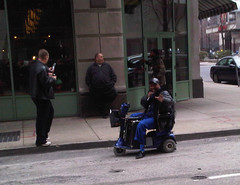
A Sonny sighting at 13th & Filbert
While I think that Sonny was always known in the city, videos of him became something of a local viral sensation parallel to the 2008 Phillies World Championship run. He was a fixture of the postseason, an expression of the sheer joy of unadulterated fandom, clad from head to toe in his Phillies red, and singing his original composition, the “Go Phillies Go!” fight song. Some cursory internet searches on him yield a few morsels of information and plenty of videos. If we can trust his bio, he was apparently a member of Harold Melvin and The Blue Notes and the Philly Intruders, though other music database sites do not seem to confirm it.
After a recent sighting, I really began to ponder this gentleman and what he does. I say that he is an artist and what he creates is art. If you have seen the man live, it is clear that what he does is as vital to him as breathing. Is that not the defining relationship between an artist and his or her art? Without a shred of irony or self-consciousness, Sonny sings his heart out all around the city whether anyone is paying attention or not. Don’t agree that he is an artist? Pretend he was a university trained MFA with the blessings of influential dealers and insiders doing a performance piece; then there would be no question about the “art” status of what he does. Or imagine that someone photographed or video recorded him and then the work was curated into an exhibition; it has now become art because someone has appropriated it and placed it within a different and specific context.
Apropos to Sonny Forriest, Jr., and certain other situations, I would argue that taste has no bearing—in fact, it doesn’t even apply. We can talk about the concept of moral, immoral, and amoral. I believe that there is also tasteful, distasteful, and let us say “a-tasteful,” or something existing outside the realm of taste. In order for this concept of “a-tasteful” to apply, there must be a true lack of self-consciousness. That said, this kind of art can still tap the emotions of a viewer.
These thoughts bring me back to the magnificent James Castle retrospective at Philadelphia Museum of Art in 2008. Here was a man compelled by an inner need to make art every day of his life, art that was intensely and personally significant to his very being, never shared with the public until after his death. Again, you can have experts and critics analyze the work, put it into a museum or gallery setting, and talk about its formal merits or how it betrays his true self-taught grasp of concepts like perspective and composition. But projecting any valuations of good or bad is simply a waste of time. Now Sonny, on the other hand, throws himself open to the world; but, I would ask, would he be acting any differently were no one listening?
No comments:
Post a Comment